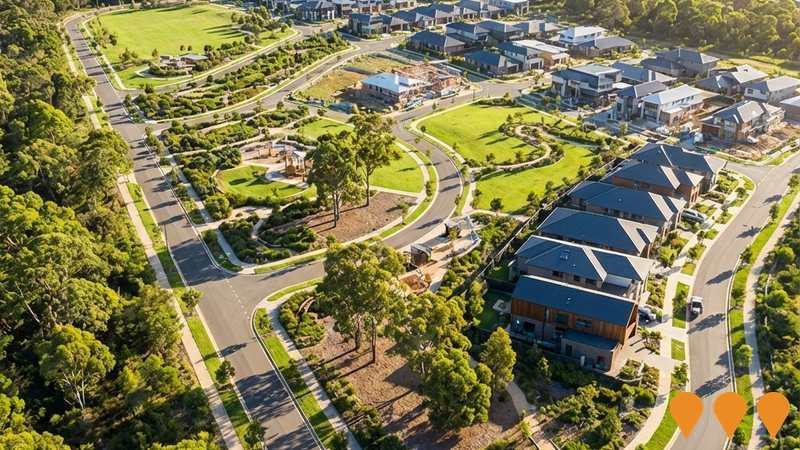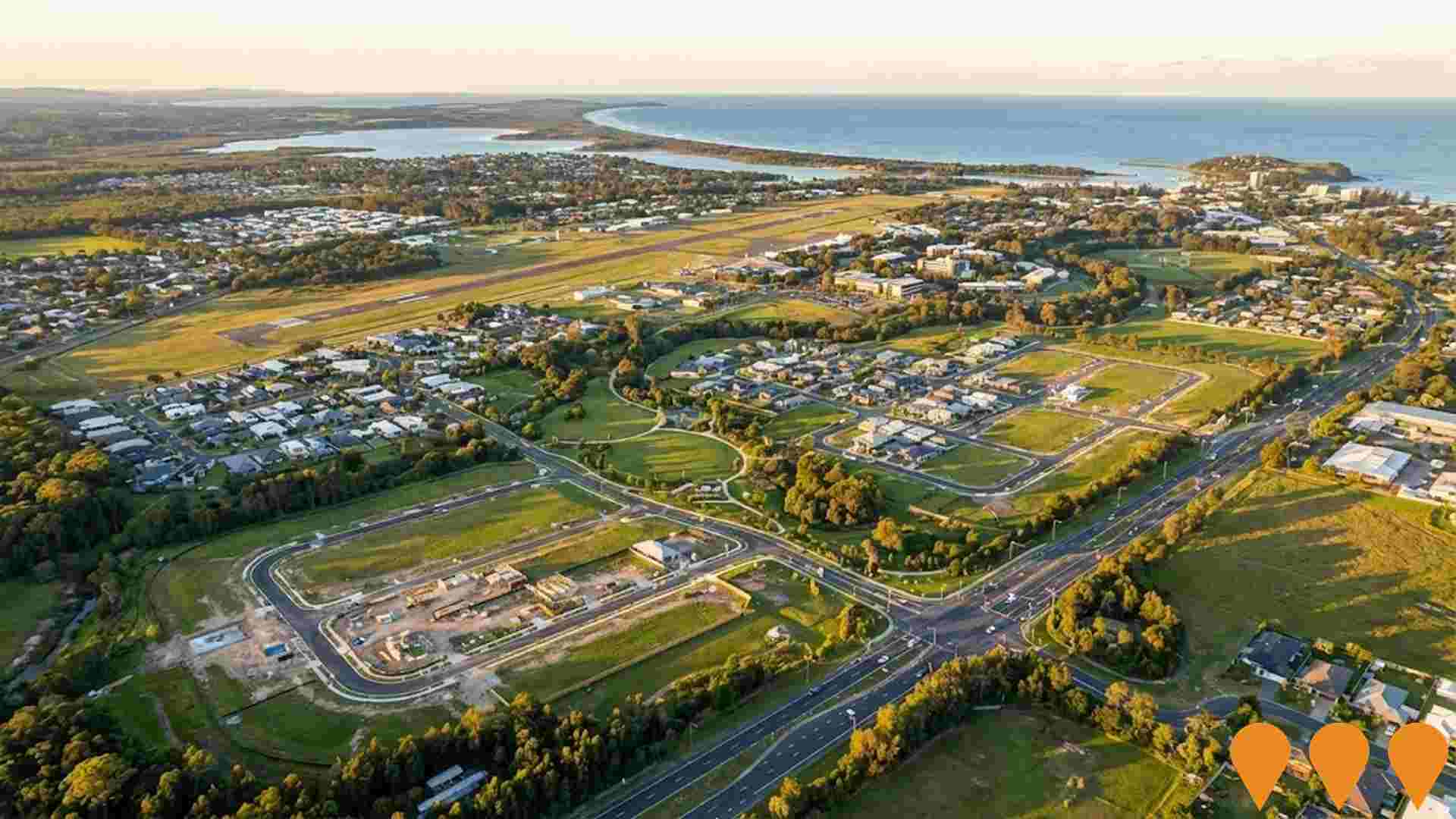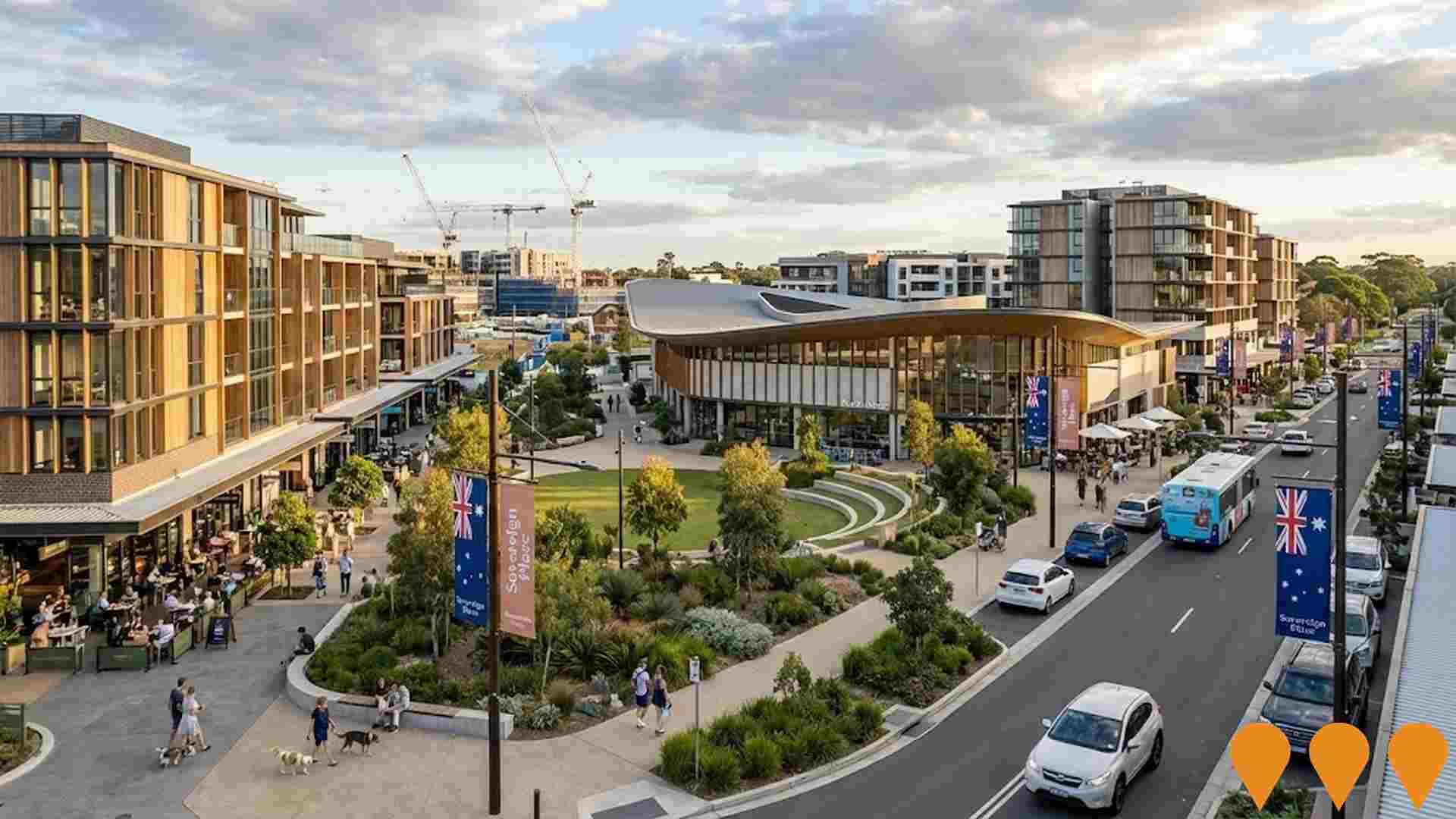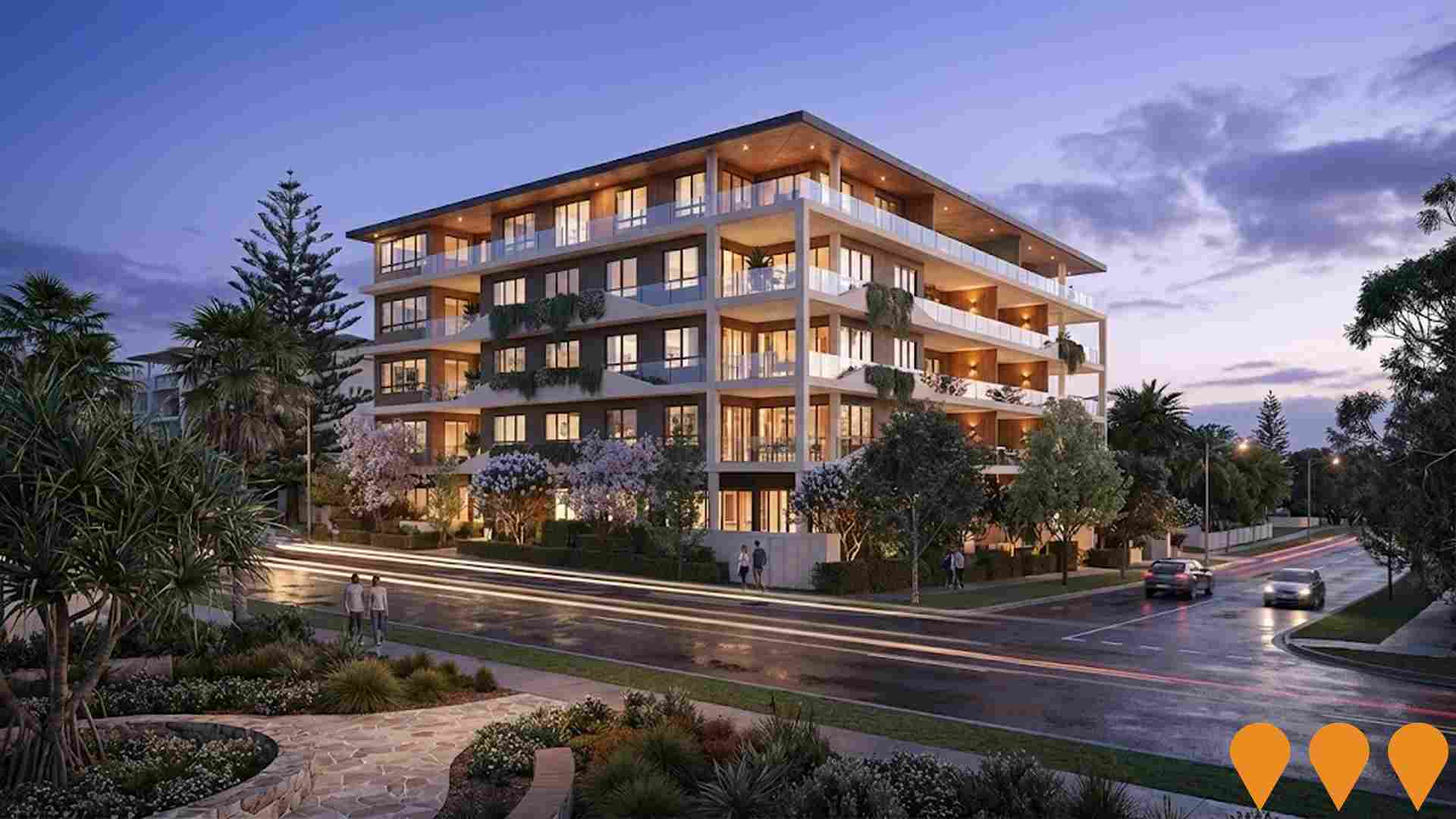Chart Color Schemes
est. as @ -- *
ABS ERP | -- people | --
2021 Census | -- people
Sales Activity
Curious about local property values? Filter the chart to assess the volume and appreciation (including resales) trends and regional comparisons, or scroll to the map below view this information at an individual property level.
Find a Recent Sale
Sales Detail
Population
Port Macquarie Surrounds is positioned among the lower quartile of areas assessed nationally for population growth based on AreaSearch's assessment of recent, and medium term trends
Port Macquarie Surrounds' population is 5,384 as of Aug 2025. This shows an increase of 83 people since the 2021 Census, which reported a population of 5,301. The change is inferred from ABS's estimated resident population of 5,297 in June 2024 and 88 new addresses validated since the Census date. This results in a density ratio of 1.9 persons per square kilometer. Port Macquarie Surrounds' 1.6% growth since census is within 3.0 percentage points of the SA4 region's 4.6%, indicating competitive growth fundamentals. Overseas migration contributed approximately 77.3% of overall population gains during recent periods.
AreaSearch uses ABS/Geoscience Australia projections for each SA2 area, released in 2024 with a base year of 2022. For areas not covered by this data, NSW State Government's SA2 level projections from 2022 with a base year of 2021 are used. Growth rates by age group from these aggregations are applied to all areas for years 2032 to 2041. Future population trends suggest an increase just below the median for locations outside capital cities, with the area expected to expand by 261 persons to 2041 based on latest numbers, recording a gain of 3.2% in total over the 17 years.
Frequently Asked Questions - Population
Development
AreaSearch assessment of residential development drivers sees a low level of activity in Port Macquarie Surrounds, placing the area among the bottom 25% of areas assessed nationally
Port Macquarie Surrounds has recorded approximately 15 residential properties granted approval annually. Over the past five financial years, from FY21 to FY25, 76 homes were approved, with an additional 10 approved so far in FY26. Despite a declining population in recent years, development activity has been adequate relative to other areas, which is beneficial for buyers.
The average construction cost value of new properties is $557,000, slightly above the regional average, indicating a focus on quality developments. In terms of commercial development approvals, $572,000 has been recorded in FY26, suggesting minimal commercial development activity. Compared to the Rest of NSW, Port Macquarie Surrounds has significantly less development activity, with 64.0% below the regional average per person. This scarcity typically strengthens demand and prices for existing properties. Furthermore, recent building activity consists solely of detached houses, preserving the area's low density nature and attracting space-seeking buyers.
The estimated population count of 376 people per dwelling approval reflects its quiet, low activity development environment. Looking ahead, Port Macquarie Surrounds is projected to grow by 173 residents by 2041. Based on current development patterns, new housing supply should readily meet demand, offering good conditions for buyers and potentially facilitating population growth beyond current projections.
Frequently Asked Questions - Development
Infrastructure
Port Macquarie Surrounds has emerging levels of nearby infrastructure activity, ranking in the 30thth percentile nationally
Changes to local infrastructure significantly impact an area's performance. AreaSearch has identified 36 projects likely to affect the region. Notable ones include Beechwood Road Upgrade Stage 6, including Steels Bridge Wauchope, The Sanctuary Port Macquarie, Sovereign Hills Master Planned Community, and Sovereign Place Town Centre. The following list details those most relevant.
Professional plan users can use the search below to filter and access additional projects.
INFRASTRUCTURE SEARCH
 Denotes AI-based impression for illustrative purposes only, not to be taken as definitive under any circumstances. Please follow links and conduct other investigations from the project's source for actual imagery. Developers and project owners wishing us to use original imagery please Contact Us and we will do so.
Denotes AI-based impression for illustrative purposes only, not to be taken as definitive under any circumstances. Please follow links and conduct other investigations from the project's source for actual imagery. Developers and project owners wishing us to use original imagery please Contact Us and we will do so.
Frequently Asked Questions - Infrastructure
Sovereign Hills Master Planned Community
A $1 billion+ premier master-planned community by Lewis Land Group in Thrumster, Port Macquarie. Up to 2,000 home lots (over 1,100 sold/built as of 2025), growing Sovereign Place Town Centre ($500m+ vision including retail, business & technology park, health & wellbeing precinct, entertainment areas), schools, childcare, extensive parks and recreational facilities. Expected to support a population of 7,000-8,000 residents.

Port Macquarie Base Hospital Redevelopment Stage 2
The $265 million Stage 2 redevelopment of Port Macquarie Base Hospital delivers expanded Emergency Department, new inpatient unit including maternity and paediatric services, upgraded operating theatres, new medical imaging department and expanded ambulatory care services. Construction commenced in late 2025 following appointment of ADCO Constructions as head contractor.

Port Macquarie Aquatic Facility
Major regional aquatic facility at Macquarie Park. Development Application approved by Northern Regional Planning Panel in November 2024. Features include a 50m outdoor pool, 25m pool with transparent roof, 20m indoor pool, gym, splash pad, and 170 parking spaces. Stage 1 and 2 valued at $67 million. Federal funding application for $13.6m was declined in January 2025; Council is pursuing alternative funding strategies.

Ocean Drive Duplication
Major infrastructure project to duplicate 3.4km of Ocean Drive from two lanes to four divided travel lanes between Green Meadows Drive (South) and Matthew Flinders Drive/Emerald Drive. The $111 million project is in its final stages as of late 2025, with asphalting, line marking, and traffic signal commissioning underway. Key features include the upgrade of five intersections, shared user paths, on-road cycle lanes, koala exclusion fencing, fauna underpasses, and a new water trunk main. Construction is managed by Ditchfield Contracting and is on track for practical completion by late 2025, significantly improving traffic flow and safety for the region's motorists.

Thrumster Business Park
Port Macquarie's first master-planned, eco-friendly industrial business park. The project offers over 60 fully serviced lots from 1,200 to 4,800 sqm across two precincts: one for community-friendly businesses (Precinct 1) and one for traditional industrial uses (Precinct 2). Stage 1 is registered and ready for development, with Stage 2 and 3 civil construction well underway. A planning proposal is also seeking an E3 zone amendment to allow for mixed-uses including 170 residential units, retail, and commercial spaces in Precinct 1.

Fernbank Creek and Sancrox Structure Plan
A strategic planning document that makes land use planning recommendations for the Fernbank Creek and Sancrox area, outlining a vision for sustainable conservation and development as a network of well-serviced villages. It proposes a potential dwelling yield of 4,500 homes across four precincts (including East Sancrox and Fernbank Creek) and guides future rezoning and infrastructure planning to support long-term growth near Thrumster. This plan is a key part of the Port Macquarie-Hastings Local Housing Delivery Plan which was adopted in August 2024.

Sovereign Place Town Centre
The commercial heart of the Sovereign Hills master planned community. Stage One is complete. The Town Centre is planned to expand to over 60,000sqm, incorporating diverse retail, a Business and Technology Park, a Health and Wellbeing Precinct, commercial offices, and a community library/town green.

Salt Town Beach
A masterpiece in contemporary design, its gentle curves harmonising with the adjacent rolling surf. Recognising the significance of the 'SALT' project, multi award-winning developers Harbourland harnessed the acclaimed skills of architects King + Campbell to create a centre of residential excellence with 15 luxury three-bedroom + study apartments offering uninterrupted coastal views.

Employment
AreaSearch assessment positions Port Macquarie Surrounds ahead of most Australian regions for employment performance
Port Macquarie Surrounds has a skilled workforce with diverse sector representation. As of June 2025, the unemployment rate is 2.8%.
The area has shown employment stability over the past year. There are 2,783 residents in work and the unemployment rate is 0.8% below Rest of NSW's rate of 3.7%. Workforce participation is similar to Rest of NSW's 56.4%. Leading industries include agriculture, forestry & fishing, health care & social assistance, and construction.
Agriculture, forestry & fishing has notable concentration with employment levels at 3.3 times the regional average. Accommodation & food employs just 4.9% of local workers, below Rest of NSW's 7.8%. The area offers limited employment opportunities locally as indicated by Census data on working population vs resident population. Over a 12-month period ending June 2025, employment increased by 0.1%, labour force grew by 0.7%, and unemployment rate rose by 0.5 percentage points. Jobs and Skills Australia forecasts national employment growth of 6.6% over five years and 13.7% over ten years. Applying these projections to Port Macquarie Surrounds's employment mix suggests local growth of approximately 6.0%% over five years and 12.8% over ten years, based on a simple weighting extrapolation for illustrative purposes.
Frequently Asked Questions - Employment
Income
Income figures position the area below 75% of locations analysed nationally by AreaSearch
Port Macquarie Surrounds' income level is lower than average nationally, according to latest ATO data aggregated by AreaSearch for financial year 2022. The median income among taxpayers was $42,365 and the average stood at $53,425. This compares with figures for Rest of NSW of $49,459 and $62,998 respectively. Based on Wage Price Index growth of 12.61% since financial year 2022, current estimates would be approximately $47,707 (median) and $60,162 (average) as of September 2025. According to 2021 Census figures, household, family and personal incomes in Port Macquarie Surrounds all fall between the 16th and 23rd percentiles nationally. Income brackets indicate that the $1,500 - 2,999 earnings band captures 29.2% of the community (1,572 individuals), consistent with broader trends across the surrounding region showing 29.9% in the same category. While housing costs are modest with 87.0% of income retained, total disposable income ranks at just the 27th percentile nationally.
Frequently Asked Questions - Income
Housing
Port Macquarie Surrounds is characterized by a predominantly suburban housing profile, with above-average rates of outright home ownership
In Port Macquarie Surrounds, as per the latest Census, 96.8% of dwellings were houses, with the remaining 3.1% comprising semi-detached homes, apartments, and other types. This contrasts with Non-Metro NSW's figures of 75.9% houses and 24.1% other dwellings. Home ownership in Port Macquarie Surrounds stood at 52%, with mortgaged properties accounting for 34.2% and rented dwellings making up 13.9%. The median monthly mortgage repayment was $1,668, lower than Non-Metro NSW's average of $1,733. Weekly rent in the area averaged $300, compared to Non-Metro NSW's figure of $375. Nationally, Port Macquarie Surrounds' mortgage repayments were significantly lower than the Australian average of $1,863, and rents were substantially below the national figure of $375.
Frequently Asked Questions - Housing
Household Composition
Port Macquarie Surrounds has a typical household mix, with a higher-than-average median household size
Family households comprise 75.3% of all households, including 29.4% couples with children, 36.0% couples without children, and 9.3% single parent families. Non-family households account for the remaining 24.7%, with lone person households at 22.0% and group households comprising 2.6%. The median household size is 2.5 people, larger than the Rest of NSW average of 2.3.
Frequently Asked Questions - Households
Local Schools & Education
Educational outcomes in Port Macquarie Surrounds fall within the lower quartile nationally, indicating opportunities for improvement in qualification attainment
The area has university qualification rates of 17.3%, significantly lower than the NSW average of 32.2%. Bachelor degrees are the most common at 12.8%, followed by postgraduate qualifications (2.3%) and graduate diplomas (2.2%). Trade and technical skills are prominent, with 46.4% of residents aged 15+ holding vocational credentials - advanced diplomas (11.9%) and certificates (34.5%). Educational participation is high, with 27.0% of residents currently enrolled in formal education.
This includes 10.6% in primary education, 8.1% in secondary education, and 2.5% pursuing tertiary education. The five schools in Port Macquarie Surrounds have a combined enrollment of 258 students, all focusing exclusively on primary education with secondary options available in nearby areas. Local school capacity is limited (4.8 places per 100 residents compared to the regional average of 14.2), leading many families to travel for schooling.
Frequently Asked Questions - Education
Schools Detail
Nearby Services & Amenities
Transport
Transport servicing is low compared to other areas nationally based on assessment of service frequency, route connectivity and accessibility
Port Macquarie Surrounds has 156 active public transport stops. These include both train and bus services. There are 46 different routes operating in total, offering 304 weekly passenger trips combined.
The accessibility of these services is rated as moderate, with residents on average being located 406 meters away from the nearest stop. On average, there are 43 trips per day across all routes, which equates to approximately one weekly trip per individual stop.
Frequently Asked Questions - Transport
Transport Stops Detail
Health
Health performance in Port Macquarie Surrounds is lower than average with common health conditions somewhat prevalent across both younger and older age cohorts
Port Macquarie Surrounds faces significant health challenges with common health conditions prevalent across both younger and older age cohorts. The rate of private health cover is very low at approximately 47% of the total population (~2,530 people), compared to the national average of 55.3%.
The most common medical conditions in the area are arthritis and mental health issues, impacting 10.6% and 8.5% of residents respectively. Meanwhile, 65.5% of residents declare themselves completely clear of medical ailments, compared to 59.9% across Rest of NSW. The area has 28.2% of residents aged 65 and over (1,516 people). Health outcomes among seniors are particularly strong, performing better than the general population in health metrics.
Frequently Asked Questions - Health
Cultural Diversity
The latest Census data sees Port Macquarie Surrounds placing among the least culturally diverse areas in the country when compared across a range of language and cultural background related metrics
Port Macquarie Surrounds, as per the 2016 Census, had a low level of cultural diversity with 90.6% citizens and 97.6% speaking English only at home. The majority religion was Christianity at 56.1%, slightly below the Rest of NSW average of 57.5%. Ancestry-wise, Australian (33.4%) and English (32.7%) were the top groups, followed by Irish at 9.3%.
Notably, Australian Aboriginal were marginally overrepresented at 3.5% compared to 3.8% regionally, while Scottish were slightly underrepresented at 8.1% versus 8.3%, and German were slightly overrepresented at 3.3% against 2.9%.
Frequently Asked Questions - Diversity
Age
Port Macquarie Surrounds ranks among the oldest 10% of areas nationwide
Port Macquarie Surrounds has a median age of 50, which is higher than the Rest of NSW figure of 43 and above the national average of 38. The 65-74 age group makes up 18.3% of its population, compared to Rest of NSW's percentage and significantly higher than the national figure of 9.4%. In contrast, the 25-34 age cohort is less prevalent at 7.1%. According to the 2021 Census, the 75 to 84 age group has grown from 6.3% to 8.0%, while the 65 to 74 cohort increased from 16.7% to 18.3%. Conversely, the 55 to 64 cohort declined from 18.5% to 16.9%, and the 45 to 54 group dropped from 13.7% to 12.2%. By 2041, demographic modeling projects significant changes in Port Macquarie Surrounds' age profile. The 75 to 84 age cohort is expected to grow by 165 people (38%), from 431 to 597. Notably, the combined 65+ age groups are projected to account for 62% of total population growth, reflecting the area's aging demographic trend. Conversely, population declines are projected for the 65 to 74 and 55 to 64 cohorts.




